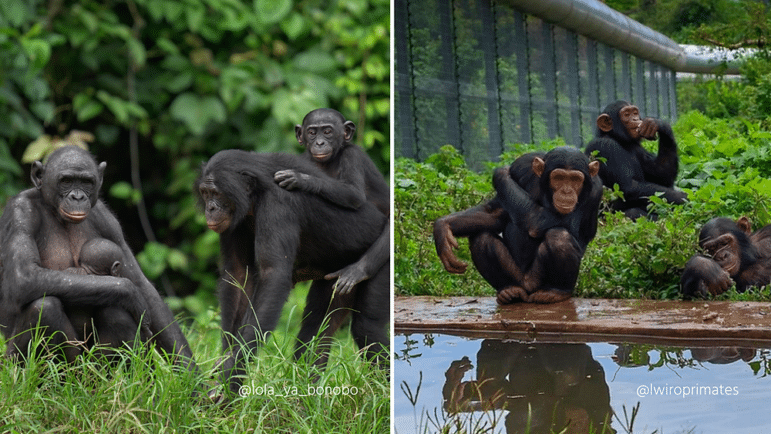Quick! Bonobo trivia! Can you name four behavioral differences between chimpanzees and bonobos?
Okay, we’ll give you a hint – think gender roles, fear of strangers, aggression, and … sex!
Are you wondering what all those things have to do with the differences in bonobo and chimp society? Read on to find out!

In addition to their physical differences, such as body shape and size, facial features, and bipedal nature, chimpanzees and bonobos have many behavioral differences that make it obvious how different the two species really are. In comparison to chimpanzees, bonobos live in matriarchal, female dominated societies that are peaceful, tolerant of strangers, and full of socio-sexual behavior.
1. Gender Roles: Bonobos Live in Female Dominated Societies
Both bonobos and chimpanzees live in societies that practice male philopatry. This means the males generally spend their whole lives with their birth group, while females tend to leave and join another group around adolescence. (Philopatry helps the animals avoid inbreeding.)

Philopatry generally leads to male-dominated societies, as is the case with chimpanzees. Why? Because the males are all related to each other and have family ties. Females, on the other hand, are the newcomers.
But among bonobos, philopatry leads to a different result. Social groups are run by the ladies! Females are at the top of the totem pole, the men below them, and the babies respected most highly of all. Babies eat first in bonobo society, then females, and finally, the males.
Babies eat first in bonobo society, then females, and finally, the males.
This is rather unusual and interesting to scientists for several reasons. First, female dominated societies are rare in the animal kingdom. Second, like chimps, bonobo females are smaller than bonobo males (although body type differences between the sexes are not as great in bonobos). This makes it clear that bonobo females don’t take the upper hand by using sheer force. And third, because bonobo females leave their natal groups to migrate to new places, they don’t have a network of related individuals to turn to for help navigating the social relations of their new groups.
So, how do the females keep the throne? The secret to their lasting power comes from two key bonobo strategies: xenophilia and strong female friendships.
2. Stranger Love: Bonobos Love Making New Friends
While chimpanzees are xenophobic, meaning they are wary of strangers, bonobos are the opposite. Chimpanzees refuse to share food with unknown individuals (and often even refuse to share with friends) and are known to patrol their territory in the wild, often acting aggressively towards strangers or even launching full blown attacks on neighboring troops.
But bonobos are xenophiles: they absolutely adore strangers! Scientists have shown that bonobos actually prefer to share food with a stranger than with a group member. And when two neighboring troops of bonobos run into each other in the wild, the result is a whole lot of uncontained excitement … which generally results in one giant orgy.
Yup, you heard us right, when bonobos meet other bonobos, they generally say hello by conducting a quick sex interview – AKA “the bonobo handshake.”

What all this means for immigrating females is that they are welcomed with open arms (and legs) when they arrive in a new group. Unlike new chimpanzee females, who are exposed to beatings and intense aggression upon arrival, bonobo females are greeted with love and more love.
Following their initial warm introduction, female group mates make quick work of bonding with their newest lady friend. They integrate her into the strong network of female friendships that allow bonobo females – through strength in numbers – to keep the power and the peace even though they are not as physically strong as bonobo males.
3. Bonobos are Peaceful, Not Violent

While chimpanzee males are known engage in violent fights over rank, kill infants, rape and beat females, and even murder other chimpanzees, bonobo societies run on the operative, “make love, not war.”
Bonobos females band together to keep troublesome aggressive behaviors in check and ensure that males stay in line. They resolve conflicts with affection – such as hugging, kissing, playing, and having sex with each other.
4. Bonobos Have (a lot) of Sex
Sex in bonobo society is nondiscriminant. Females have sex with males, males with males, females with females, young with old, old with old, and even little ones with each other. Most of it has nothing to do with making babies. (A bonobo gives birth about every 5 years.) It may sound strange to us humans, but this is the unique way bonobos have evolved.

They use sexual contact as a tool to build close group relationships, to calm each other down, and to resolve social conflicts.
If that seems weird to you, just take a moment and imagine where our society might be if we resorted to love and sex instead of interpersonal conflict and large-scale war… and then wonder – which group of apes truly deserves the label “civilized”?



